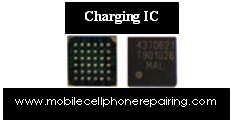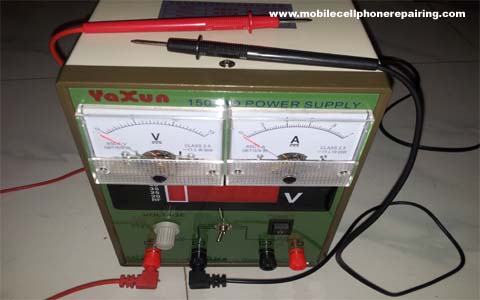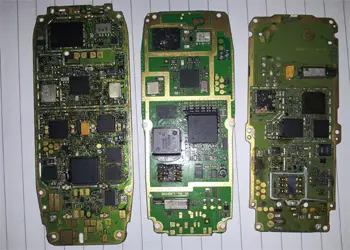When doing mobile phone repairing, you will often need to check parts such as speaker, ringer, vibrator, coil, boost coin, On / Off Switch, Antenna Switch, RX Filter, PFO, BSI, Network IC, VCO, Audio IC, Power IC, RTC, Charging IC, CPU, R22, Microphone Interface, Bluetooth IC, Flash IC, RAM, Logic IC, UEM etc.
In most cases, only card level parts of a mobile cell phone are checked for fault and then repaired or replaced with a new one. Card level parts of a mobile cell phone include ringer, speaker, microphone, vibrator, LED, charging connector, headphone connector, data cable connector, battery, battery connector, SIM card, SIM card connector, memory card, memory card connector, camera, camera connector, keypad button, keypad connector, ON / OFF Switch, Display, Display connector, Internal antenna and PDA.
Chip level small parts of a mobile phone that include small electronics components like capacitors, resistor, diode, coil, boost coil, coupler, regulator, transistors, are rarely or not tested for fault. In case there is any fault in the track of the Mobile Phone PCB then it is solved or fixed by jumper.
Mobile Phone Tools and Equipment Needed to Check Parts of a Mobile Phone for Fault are:
How to Check Parts of a Mobile Phone for Fault
- Ringer: To check if the ringer of a mobile phone is faulty or damaged,
![Multimeter for Mobile Phone Repairing Multimeter for Mobile Phone Repairing]()
Multimeter for Mobile Phone Repairing
keep the multimeter in buzzer mode and check the ringer. Value must be between 8 to 10 Ohms. If the value is between this range then the ringer is good and does not need replacement. If the value on multimeter is 4-5 or 12-14 then change the ringer.
- Vibrator or Motor: Keep the multimeter in Buzzer Mode and check the vibrator, Value must be 8 to 16 Ohms. If the value is between 8-16 Ohms then the vibrator is good. Otherwise change it.
- Speaker or Earpiece: Check the speaker / earpiece with a multimeter on Buzzer mode. Value must be in the range of 25 to 35 Ohms. If the value is in this range then the speaker / earpiece is OK and need not be changed. Otherwise, change the speaker / earpiece.
- Microphone or Mic: Keep the multimeter in buzzer mode and check the microphone. Value reading on the multimeter must be in the range of 600 to 1800 Ohms. There will also be a Beep or Buzz sound from the multimeter. NOTE: Please note that only one side of the microphone will show value. If we check by reversing the Red and Black Probes / Test Leads of the multimeter and check the microphone then there will be no value.
- Coil: Check it with a multimeter on Buzzer Mode. If it is good then it the multimeter will give a Beep or Buzz sound. If there is no sound then the coil is faulty. Replace it with a new one.
- Resistor or Resistance: Check it with a multimeter on Buzzer Mode. If it is good then the multimeter will give a Beep or Buzz sound. If there is no sound then the resistor is faulty. Replace it with a new one.
- Capacitor: Check it with a multimeter on Buzzer Mode. If it is good then the multimeter will NOT give any Beep or Buzz sound. If there is sound then the capacitor is faulty. Replace it with a new one.
- Diode: Check it with a multimeter on Buzzer Mode. If it is good then the multimeter will NOT give any Beep or Buzz sound. If there is sound then the diode is faulty. Replace it with a new one.
- LED: Keep the multimeter in Buzzer mode and check the LED. If the LED is good then they will glow otherwise not.
- Coil and Boosting Coil: Check for continuity. If there is continuity then the coil or the Boost Coil is good otherwise it is faulty.
- Keypad: Keep the multimeter on Buzzer mode and check Rows and Columns or the Key Pad. If there is Beep or Buzz sound from the multimeter then Keypad is ok, otherwise it is faulty.
- Battery Connector: Keep multimeter on 20V DC and check. Value must be 1.5 to 3.5 V DC.
- Battery: Check voltage with a multimeter. Keep multimeter on 20V DC and check. Value must be 3.7 V DC or above.
- ON / OFF Switch: Check voltage with a multimeter. Keep multimeter on 20V DC and check. Value must be between 2.5 to 3.7 V DC.
- Network IC: Use a Analog DC Power Supply to check Network IC. Switch ON DC Power Supply and call any number from your mobile phone. The Needle of the DC Ampere will start moving. This shows that the Network IC is OK and not fault.
- Power IC and CPU: Adjust voltage of the DC Power Supply to 4.2. Place the Red Probe / Test Lead of the DC Power Power Supply to the “+” of the Battery Connector of the mobile phone and the Black Probe / Test Lead to “-“. If DC Ampere is over 6 then Power IC or CPU is damaged. Check by replacing Power IC and the CPU one by one.
- If there is no movement of the Ampere Needle of the Power Supply then the Battery connector, On / OFF Switch Track, RTC or Network Crystal is damaged. Give heat to these components using hot air blower. If the problem is not solved then check by replacing them one by one.
- If the Ampere Needle fluctuates below 2 ten there could be problem with software or RTC (Real Time Clock).
- If the Ampere needle stands at some fixed point then there is problem with the Flash IC.
- If there is beep sound from the DC Power Supply then there is problem with “+” and “-” or the mobile handset is short.
PS: When checking a faulty mobile phone with DC Power supply, connect the Red Probe to “+” and Black Probe to “-” of the Battery Connector of the Mobile Phone.
![DC Power Supply DC Power Supply]()
DC Power Supply
Notes:
- Most mobile phone repair people and technician check only above parts of any mobile phone to solve hardware problems.
- All other parts including electronic components and ICs are generally not checked for fault. There is no good sure test for these parts. The problem is either solved by jumper or by trial and error (check by replacement).
Related Posts:



























